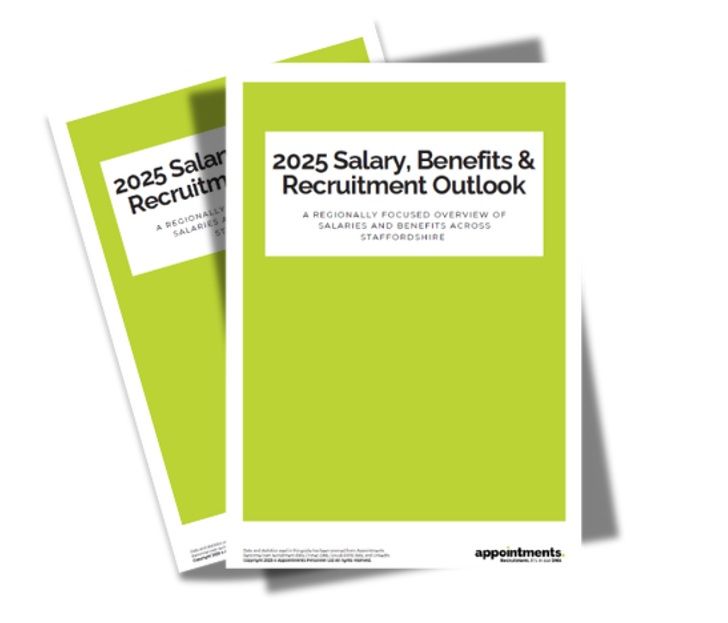
Share Article
Flexible Working in Staffordshire
Flexible working is fast becoming the norm for many office support staff throughout Staffordshire, Stoke on Trent and Cheshire but how do you know if it’s right for yours? Well, Appointments have the info you need to help you decide.
Is it Right for Your Business?
Flexible working isn’t a new concept. In fact, it has been around for over 20 years, however, it has taken a global pandemic to thrust it into the office support world of work, a business function that has almost always been office based. But, whilst it is becoming the new normal for many businesses throughout Staffordshire and Cheshire, is it right for every business? And more importantly, is flexible working right for your business?
What is flexible working?
Before deciding whether flexible working is right for your business, it helps to understand exactly what flexible working is. Many people now assume flexible working means working from home and whilst this isn’t incorrect, there are many other options that fall under the flexible working umbrella, these include:
- Working from home (also referred to as hybrid or remote working)
- Flexitime
- Compressed hours
- Job shares and partnerships (not to be confused with part-time working)
- Interim or freelance assignments
- Annualised hours
- Phased retirement
As you can see, there are a wide range of flexible working examples that can be considered for your business but how do they benefit you and your employees.
Why is flexible working good for business?
From talent attraction to talent retention, from increased productivity to employee wellbeing, the benefits of flexible working are endless. However, it’s important to look at these benefits in more detail and consider which of the flexible working options are most beneficial to your business. According to the results of the Work Trend Index 2022, whilst less than 45% of business leaders in the UK fear productivity has been negatively impacted with the introduction of flexible working, over 80% of workers say they are as productive or even more productive compared to a year ago.
Talent Attraction and Retention
In Cheshire and Staffordshire alone, there are over 2500 office support roles currently being advertised and according to the Work Trend Index 2022 over 40% of the UK workforce are expecting to leave their current employer this year and they are looking for more than just a better salary. The pandemic gave employees the opportunity to revaluate what they wanted from their careers and lives and also gave them insight into how valued they truly are by their employer. To summarise, these included:
- Flexible working options
- Robust wellbeing programmes
- Professional development opportunities
In a survey by the Centre for the Modern Family, 23% of UK workers would be willing to take a pay cut in order to have more flexible working hours.
Employee Wellbeing
It’s long been known that people who are happy, healthy and engaged with their job are more motivated and productive. And flexible working can play a big part of that. According to the Work Trend Index 2022 survey 53% of people are now more likely to prioritize their health and wellbeing over work.
In a recent article from the flexible working consultancy Timewise, they found that:
- Employees who have a good work-life balance are less prone to stress and illness
- Employees who are allowed some autonomy in choosing when and where they work feel they have a sense of control and are therefore more engaged
- Employees who have children or other caring responsibilities feel better able to manage their career and their personal commitments rather than feeling like they have to choose between them
So, now you know what, and why, let’s have a look at how.
How to start implementing flexible working
It’s important to remember that whilst you have to consider if flexible working is right for your office support function, and overall business, it’s also essential to find out how your current employees feel about it.
The Work Trend Index also found:
over 50% of workers are considering a switch to remote or hybrid in the year ahead , while over 50% of hybrid workers feel lonelier at
work than before shifting to hybrid.
So, before making any final decisions, it is recommended to survey or speak directly to your employees and discuss how they feel about flexible working options. This would also be a good time to have an informal discussion about how they are currently feeling and how they see their career moving forward.
Once you understand how your employees feel about flexible working and the types of flexible working, they would like to have available, you can start thinking about which options are right and manageable for your business.
Conclusion
Implementing flexible working is a big undertaking, much too big a topic to cover fully in one blog. However, the benefits are clearly evident and can go a long way to helping you become an employer of choice within the Cheshire and Staffordshire areas. Remember to communicate open and honestly with your current employees and if your business does not already have a HR department, we would strongly recommend sourcing additional support to ensure any changes are done correctly.
You can give us a call if you need help and advice about how to implement flexible working in your workplace. Call 01782 338787 or email kerry@appointmentspersonnel.co.uk










